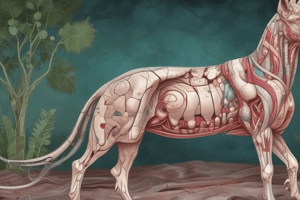Podcast
Questions and Answers
Which layer of the epidermis is responsible for the production of melanin?
Which layer of the epidermis is responsible for the production of melanin?
- Stratum granulosum
- Stratum lucidum
- Stratum corneum
- Stratum basale (correct)
What primary function does the hypodermis serve?
What primary function does the hypodermis serve?
- Preventing water loss
- Synthesis of vitamin D
- Providing sensory receptors for touch and pain
- Serving as insulation and energy storage (correct)
Which component of sweat glands is primarily responsible for thermoregulation?
Which component of sweat glands is primarily responsible for thermoregulation?
- Eccrine glands (correct)
- Apocrine glands
- Sebaceous glands
- Stratum corneum
Which layer of the dermis contains thick collagen fibers and elastic fibers?
Which layer of the dermis contains thick collagen fibers and elastic fibers?
Which type of respiration is characterized by periods of rapid respirations followed by periods of apnea?
Which type of respiration is characterized by periods of rapid respirations followed by periods of apnea?
What function does the stratum corneum primarily provide?
What function does the stratum corneum primarily provide?
Which major function of the lungs involves the movement of gases between the alveoli and the pulmonary capillaries?
Which major function of the lungs involves the movement of gases between the alveoli and the pulmonary capillaries?
What type of glands secrete sebum to lubricate hair and skin?
What type of glands secrete sebum to lubricate hair and skin?
Which structure is described as invaginations in the epidermis that hold hair shafts?
Which structure is described as invaginations in the epidermis that hold hair shafts?
What is the role of the lungs in regulating acid-base balance?
What is the role of the lungs in regulating acid-base balance?
Flashcards are hidden until you start studying
Study Notes
Integumentary System: Structure and Function
- Provides first line of defense in immune system
- Regulates body temperature
- Assists in synthesis of Vitamin D
- Prevents water loss
- Sensory receptors provide for touch, pain, temperature, and pressure
Integumentary System Layers
- Epidermis: outermost layer, composed mainly of keratinized, stratified squamous epithelium
- Stratum Corneum: most superficial layer, composed of dead cells, provides tough, protective barrier
- Stratum Lucidum: clear layer, found only in thick skin (palms, soles)
- Stratum Granulosum: cells produce keratin granules, release lipids to waterproof skin
- Stratum Spinosum: cells produce keratin, giving skin strength and elasticity
- Stratum Basale: deepest layer, contains melanin-producing cells and stem cells for skin renewal
- Dermis: dense, fibrous connective tissue, provides support
- Contains blood vessels, nerve fibers, hair follicles, sweat glands, and sebaceous glands
- Papillary Layer: superficial layer with thin collagen fibers and capillaries for nourishment
- Reticular Layer: deeper layer with thick collagen fibers and elastic fibers for strength and resilience
- Hypodermis: subcutaneous layer, composed of adipose tissue and loose connective tissue
- Serves as insulation, energy storage, and cushioning
Integumentary System Components
- Hair: composed of keratin
- Hair Follicles: invaginations in epidermis, hold hair shafts
- Sebaceous Glands: secrete sebum (oil) that lubricates hair and skin
- Nails: composed of keratinized cells formed in nail matrix
- Nail Body: visible portion of nail
- Nail Root: hidden under skin
- Lunula: white, crescent-shaped area at base of nail
- Sweat Glands: exocrine glands that secrete sweat
- Eccrine Glands: widespread, produce watery sweat for thermoregulation
- Apocrine Glands: found in axillae and groin, produce thick sweat that is odorless but can become malodorous in presence of bacteria
Respiratory System
Major Functions of the Lungs
- Ventilation: air movement into and out of lungs
- Diffusion: movement of gases between alveoli and pulmonary capillaries
- Perfusion: blood flow through pulmonary capillaries
- Gas Exchange: movement of oxygen from alveoli to blood and movement of carbon dioxide from blood to alveoli
- Regulation of acid-base balance: lungs help regulate pH of blood by removing carbon dioxide
- Filter: removes foreign bodies from respiratory system, helps protect body from disease
Breathing Patterns
- Quiet Respiration: normal, relaxed breathing
- Forced Respiration: breathing that is more forceful than normal
- Cheyne-Stokes Respiration: characterized by periods of alternating deep and shallow breaths
- Kussmaul Respiration: characterized by rapid, deep, and labored breathing
- Biots Respiration: characterized by periods of rapid respirations followed by periods of apnea
Nursing Care
- Assess respiratory status: determine patient's respiratory rate, rhythm, and depth
- Monitor respiratory status: continuously assess patient's respiratory status
Studying That Suits You
Use AI to generate personalized quizzes and flashcards to suit your learning preferences.




